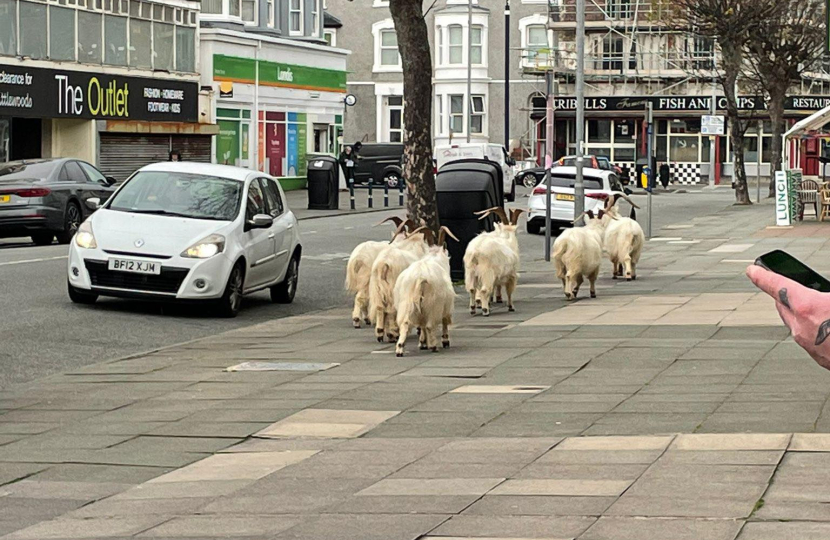
Last week saw Conwy County Borough Council’s Economy and Place Overview and Scrutiny Committee approve a multi-agency Llandudno Goat Management Plan. The plan is designed to inform the public who to contact in the case of an injured or distressed goat, or where damage or fouling is occurring on the public highway.
Unfortunately however, the Plan states that, there is no assistance or recourse for those whose property has been invaded and gardens destroyed by our Kashmir neighbours. Emboldened since the pandemic, the goats have now made it their habit to roam into town and feast on hedges and flowers. The Council’s response is that this is the landowners issue and they need to take all steps responsible to secure their land.
Speaking in response to this decision, Janet said:
“I am pleased to see that Conwy County Borough Council has taken steps to formulate a Goat Management Plan and that they have been able to define the roles and responsibilities of the various agencies needed to make it work.
“The Goats are a much loved mascot of our town. However, we have to accept that their habits and number have been influenced by the pandemic and they have now taken to roaming beyond the Great Orme into the town when it is not safe for them to do so.
“I have been contacted by a number of constituents, many from vulnerable sections of our society, who are extremely distressed by the arrival of a group of Billies to their neighbourhoods and the damage they inflict to their beloved gardens.
“I am not sure that it is good enough for councillors to say that it is just ‘hard luck’ if your garden is destroyed. Many residents are not able to make their land ‘goatproof’ due to land restrictions or financial concerns.
“I would like to see the Council go further and strengthen its intervention protocols to more frequently move goats back to the Orme when they occupy the neighbourhoods of the elderly, vulnerable or those living in open planned estates who are unable to defend their own properties.”
ENDS
Photo: Goats in Llandudno
Yr wythnos ddiwethaf cymeradwyodd Pwyllgor Trosolwg a Chraffu Economi a Lle Cyngor Bwrdeistref Sirol Conwy gynllun amlasiantaeth Rheoli Geifr Llandudno. Bwriad y cynllun yw rhoi gwybod i'r cyhoedd gyda phwy ddylen nhw gysylltu mewn achosion o eifr sydd wedi’u hanafu neu mewn gofid, neu mewn achosion o ddifrod neu faeddu ar y briffordd gyhoeddus.
Yn anffodus fodd bynnag, mae'r Cynllun yn nodi nad oes cymorth nac atebolrwydd i'r rhai lle mae geifr wedi bod yn ei gerddi a’u dinistrio. Ers magu hyder dros y pandemig, mae'r geifr bellach wedi’i gwneud hi'n arferiad i grwydro i'r dref a gwledda ar wrychoedd a blodau. Ymateb y Cyngor yw mai mater perchnogion tir yw hyn, ac mae angen iddyn nhw gymryd pob cam sy'n gyfrifol i sicrhau bod eu tir yn ddiogel.
Wrth siarad mewn ymateb i'r penderfyniad hwn, dywedodd Janet:
"Rwy'n falch o weld bod Cyngor Bwrdeistref Sirol Conwy wedi cymryd camau i lunio Cynllun Rheoli Geifr a'u bod wedi gallu diffinio swyddogaethau a chyfrifoldebau'r gwahanol asiantaethau sydd eu hangen i wneud iddo weithio.
"Mae'r Geifr yn fasgot annwyl iawn i'n tref ni. Er hynny, mae'n rhaid derbyn bod eu harferion a'u niferoedd wedi’u dylanwadu gan y pandemig ac maen nhw nawr wedi cymryd at grwydro y tu hwnt i'r Gogarth i mewn i'r dref pan nad yw'n ddiogel iddyn nhw wneud hynny.
"Mae nifer o etholwyr wedi cysylltu â mi, llawer o bobl fregus ein cymdeithas, sy'n bryderus iawn gweld grŵp o fuchod geifr yn crwydro’u cymdogaethau a'r difrod y maen nhw’n ei achosi i'w gerddi annwyl.
"Dydw i ddim yn siŵr ei bod hi'n ddigon da i gynghorwyr ddweud mai dim ond 'anlwc' yw hi os caiff eich gardd ei dinistrio. Dyw llawer o'r trigolion ddim yn gallu gwneud eu tir yn ddiogel rhag geifr oherwydd cyfyngiadau tir neu bryderon ariannol.
"Hoffwn weld y Cyngor yn mynd ymhellach a chryfhau ei brotocolau ymyrraeth i symud geifr yn amlach yn ôl i'r Gogarth pan fyddan nhw’n meddiannu cymdogaethau'r henoed, pobl fregus neu'r rhai sy'n byw mewn ystadau agored nad ydyn nhw’n gallu amddiffyn eu heiddo eu hunain."
DIWEDD
Ffoto: Geifr yn Llandudno

